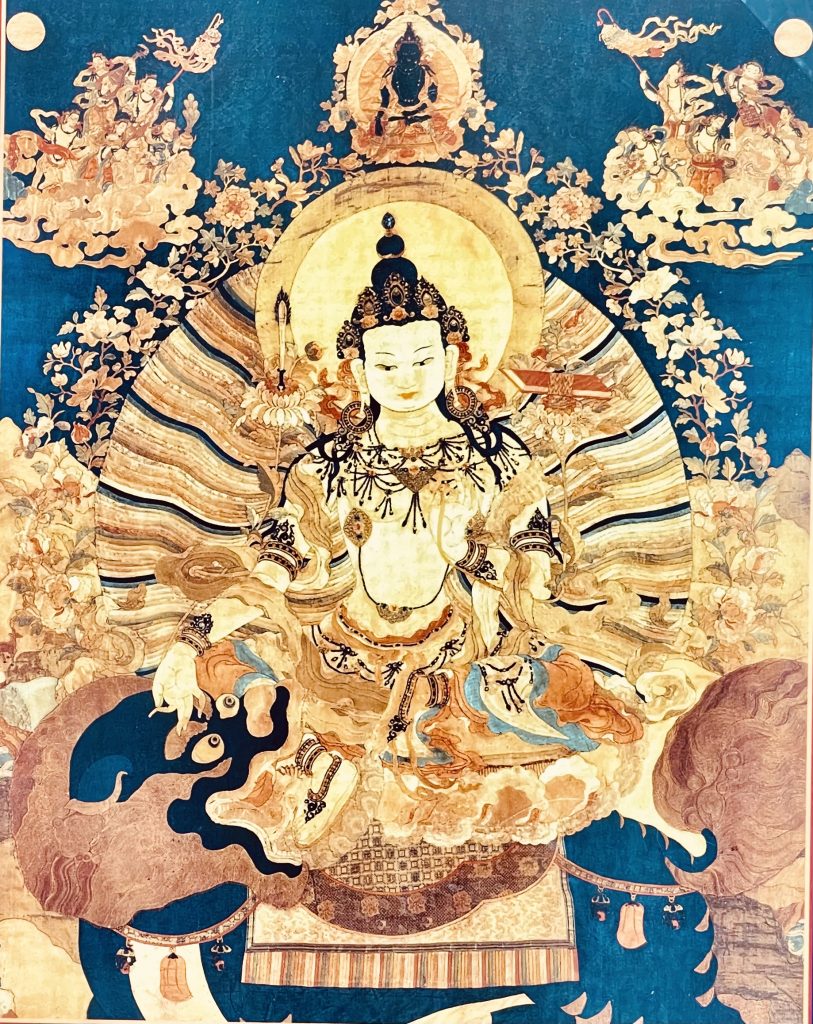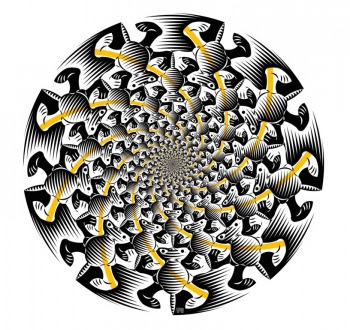From the “The Main Body of the Text” of “A Garland of Views: A Guide to View, Meditation, and Result in the Nine Vehicles“ Padmasambhava’s classic text (bold) with commentary by Jamgön Mipham, herein an excerpt:
EXPLANATION OF THE BODHISATTVA VEHICLE
The view of those engaged in the Bodhisattva Vehicle is that, on the ultimate level, all phenomena, whether of total affliction or of complete purity, are devoid of inherent existence, while on the relative level, they are mere illusions, each with its own distinct characteristics. As a result of their training in the ten transcendent perfections, bodhisattvas proceed in stages through the ten levels, at the end of which, they attain unsurpassable enlightenment.
The Bodhisattva Vehicle takes its name from its cause. Its result is no different from that of the secret mantras, so both the Mantra Vehicle and the vehicle of the transcendent perfections constitute the same Great Vehicle. However, they differ in their path, which here is the vehicle of characteristics¹. The view of those engaged in this vehicle is that the whole of the total affliction that is samsara, in both cause and result, and of the complete purity that is nirvana, in both cause and result, is completely devoid of inherent or true existence on the ultimate level. The essence of the ultimate truth is freedom from mental elaboration, and it is called ultimate because it is the object of the ultimate gnosis, or because it is the highest of all attainments.
The ultimate truth can be divided into two kinds: the nominal ultimate truth, in which conceptual elaborations have been partially annulled, and the ultimate truth in itself, where all conceptual elaborations have been completely pacified.
The relative (literally, “all-covering”) truth is deluded consciousness together with appearances. It is so called because the true condition of things is “covered” —that is, veiled and conceptualized, by obscurations or by adventitious deluded thoughts. It is subdivided into correct relative truth and mistaken relative truth². As far as this relative truth is concerned, phenomena, which lack true existence, appear in the manner of mere illusions. Here the word “mere” excludes them from being established as real. On the level of mere appearance³, things have the ability to fulfill their respective functions and it would be wrong to deny them, saying that they do not exist. They are objects of pure and impure experience and have individual, distinct characteristics, for they exist on the level of conventional evaluative methods of valid cognition.
Provisionally, things are thus ascertained in terms of the two kinds of valid cognition, and on the ultimate level, they are correctly established as the great sameness free of elaboration, the union of appearance and emptiness, the inseparability of the two truths.
Once this has been done, there follows the path of meditation. This is indicated by “the ten transcendent perfections,” referring to the ten virtuous practices (generosity and the rest) imbued with wisdom—and of all the various kinds of wisdom, the supreme and most perfect is nondual gnosis. The expression “transcendent perfections” is used for these ten virtuous practices because they “go beyond,” in the sense that they attain to what we call the ultimate reality free of elaboration, which is not an object of the intellect but transcends it, and also because they go to the other side of the ocean of samsara. There are thus two ways to apply this expression on the path.
Practicing in this way, bodhisattvas proceed in stages through the ten levels, which are the intermediate results of the practice. Its final result is the accomplishment of unsurpassable enlightenment, characterized by the completion of all the host of qualities, such as those of strength and fearlessness, which are superior to those of the listeners and solitary realizers.
Notes
¹The cause of the Bodhisattva Vehicle is bodhicitta, the mind set on supreme enlightenment, and bodhisattvas are those who have that bodhicitta. In the present context, the terms “Bodhisattva Vehicle,” “vehicle of the transcendent perfections,” and “vehicle of characteristics” are synonymous.
²Correct relative truth (Tib. yang dag pa’i kun rdzob) covers all things that are conventionally designated as being “true” by ordinary people (though their perceptions are, of course, deluded with regard to the ultimate nature of phenomena). Such things are also perceived as capable of performing their respective functions. Mistaken relative truth (Tib. log pa’i kun rdzob), on the other hand, covers those things that ordinary people generally consider to be false and that are incapable of performing functions. An example of correct relative truth is a lake, which by common consensus contains water, which in turn has the functions or properties of moistening and quenching thirst. By contrast, a mirage contains no water and cannot quench a desert traveler’s thirst. It is therefore classified as mistaken relative truth.
³Tib. snang tsam po— that is, ordinary appearances.
Glossary
bodhicitta (Skt.), Tib. byang chub kyi sems. Literally, “the mind of enlightenment.” On the relative level, it is the wish to attain buddhahood for the sake of all beings, as well as the practice of the path of love, compassion, the six transcendent perfections, and so forth, necessary for achieving that goal; on the ultimate level, it is the direct insight into the ultimate nature.
bodhisattva (Skt.), Tib. byang chub sems dpa’. A follower of the Great Vehicle whose aim is perfect enlightenment for all beings. One who has taken the vow of bodhicitta and practices the six transcendent perfections.
Great Vehicle, Tib. theg pa chen po, Skt. mahayana. The vehicle of the bodhisattvas, referred to as “great” because it leads to perfect buddhahood for the sake of all beings.
nirvana (Skt.), Tib. mya ngan las ‘das pa. Literally, “beyond suffering” or “the transcendence of misery.” While this can be loosely understood as the goal of Buddhist practice, the opposite of samsara or cyclic existence, it is important to realize that the term is understood differently by the different vehicles: the nirvana of the Basic Vehicle, the peace of cessation that an arhat attains, is very different from a buddha’s “nondwelling” nirvana, the state of perfect enlightenment that transcends both samsara and nirvana.
ten levels, Tib. sa bcu, Skt. dasabhumi. The ten stages of realization by which a sublime bodhisattva progresses toward enlightenment, beginning with the first level on the path of seeing. The nine other levels occur on the path of meditation. The eighth, ninth, and tenth levels are termed the three pure levels, or great levels.
ten transcendent perfections, Tib. pha rol tu phyin pa bcu, Skt. dasaparamità.Transcendent generosity, discipline, patience, diligence, concentration, and wisdom, together with transcendent means, aspirational prayer, strength, and gnosis. Each of these ten is practiced predominantly on one of the ten bodhisattva levels generosity on the first level, discipline on the second, and so forth. They are termed “transcendent” because their practice involves realization of the view of emptiness.
total affliction, Tib. kun nas nyon mongs pa, Skt. samklesa. The opposite of complete purity, equivalent to samsãra, and associated with the truth of suffering and the truth of the origin.
vehicle of characteristics, Tib. mtshan nyid theg pa, Skt. Laksanayana. Also called the causal vehicle of characteristics. The vehicle that teaches the path as the cause for attaining enlightenment. It includes the vehicles of the listeners, solitary realizers, and bodhisattvas (that is, those bodhisattvas practicing the sutra path and not that of the mantras). It is distinct from the resultant vehicle of the mantras, which takes the result (that is, enlightenment) as the path.




